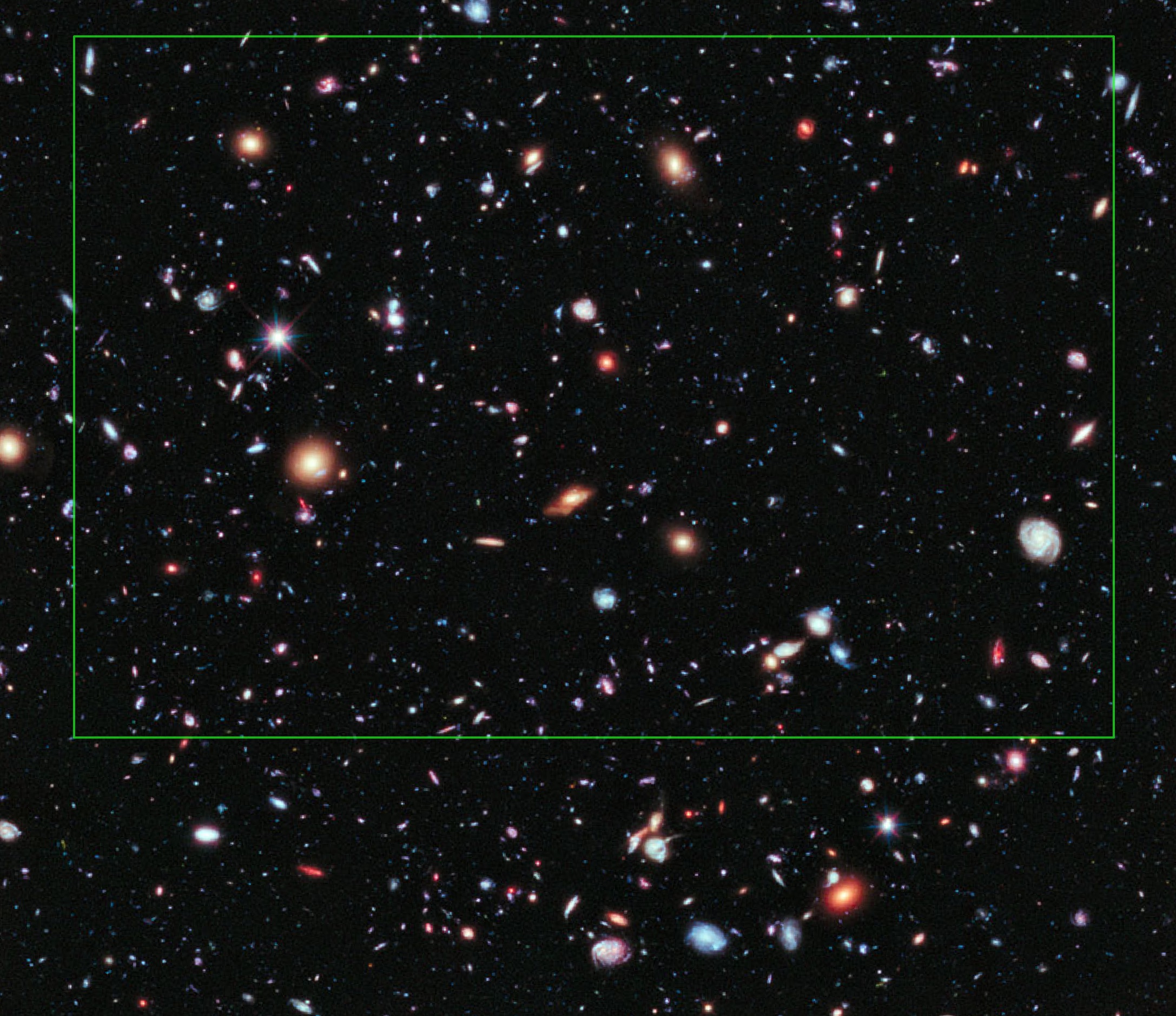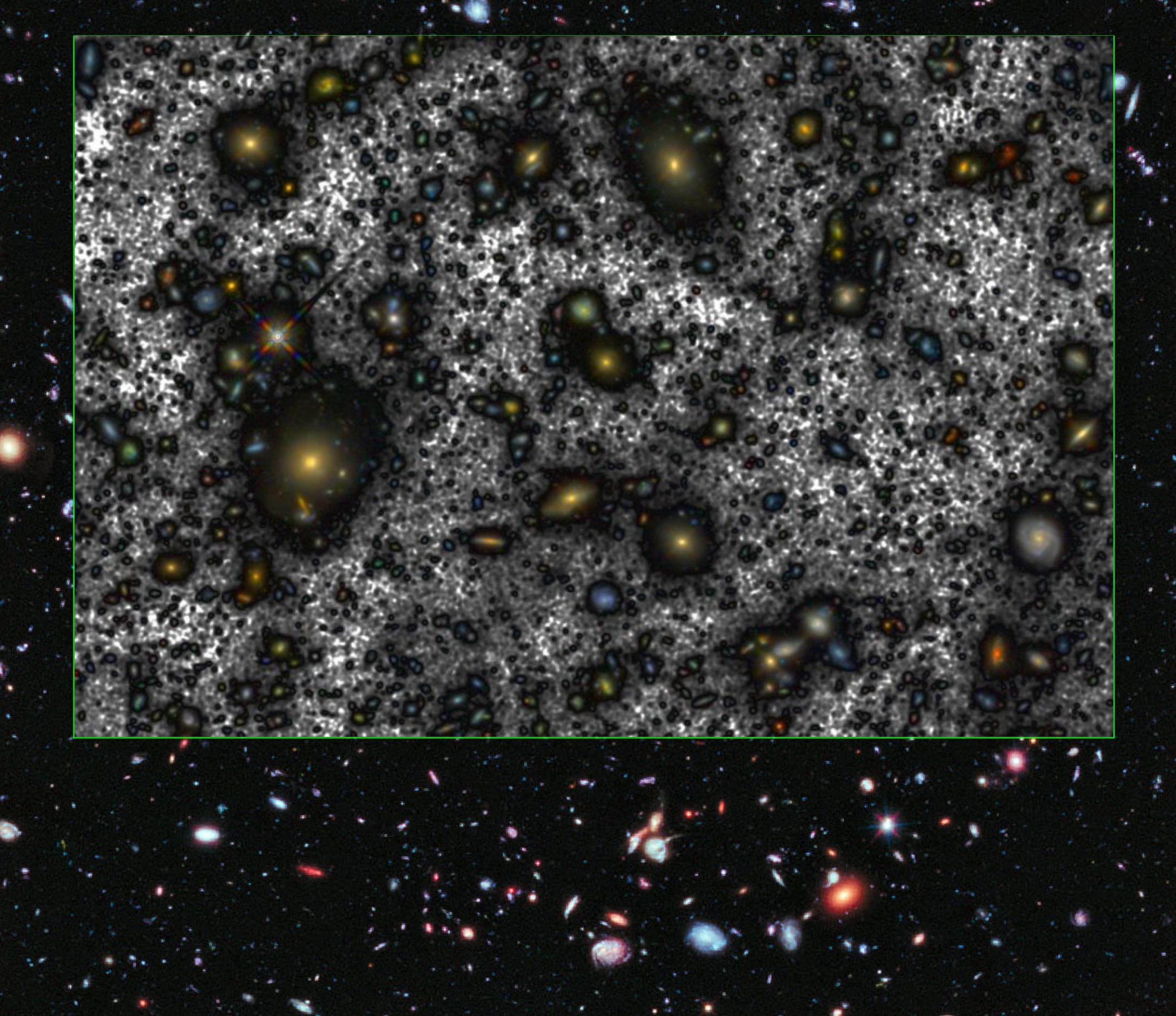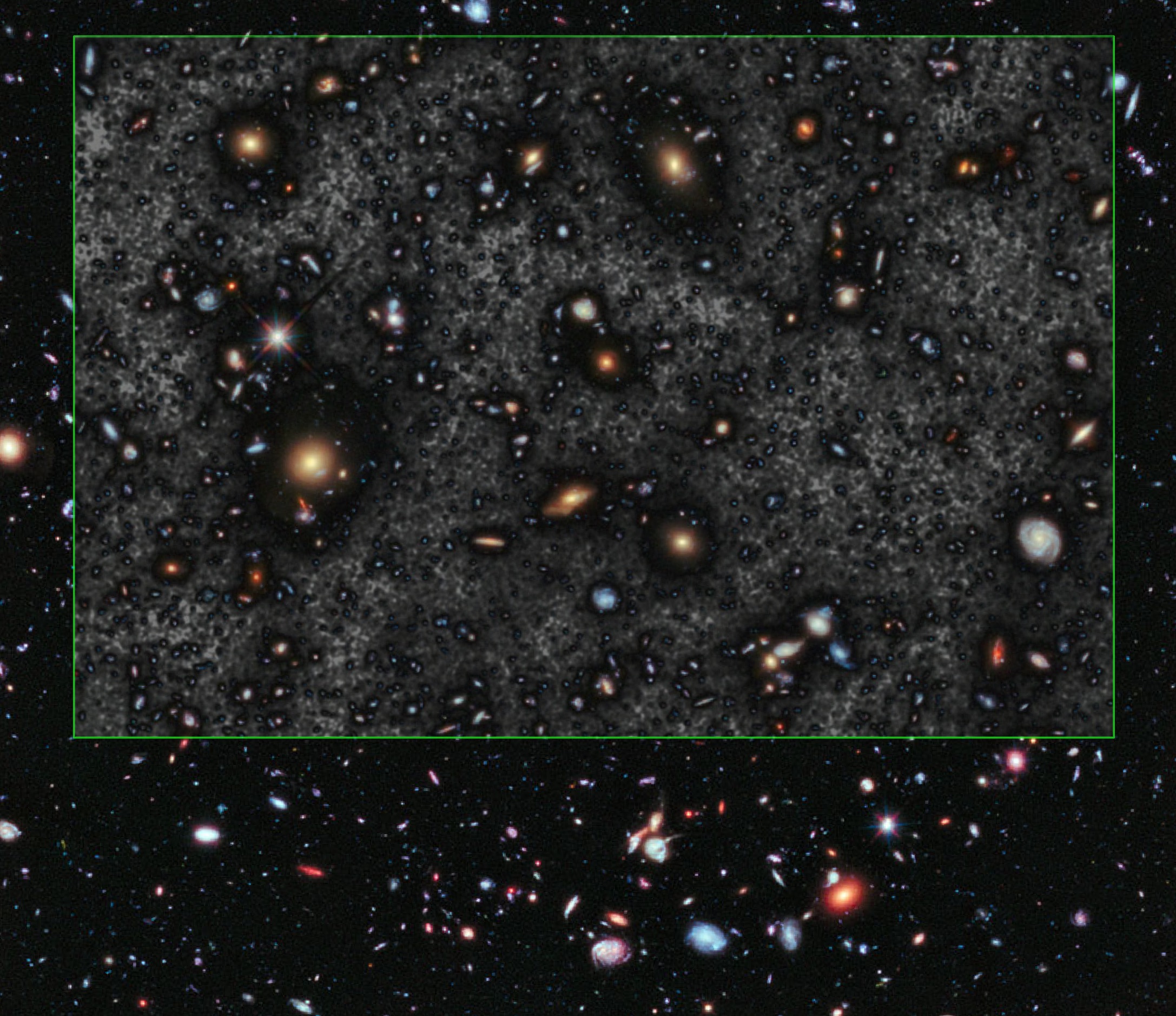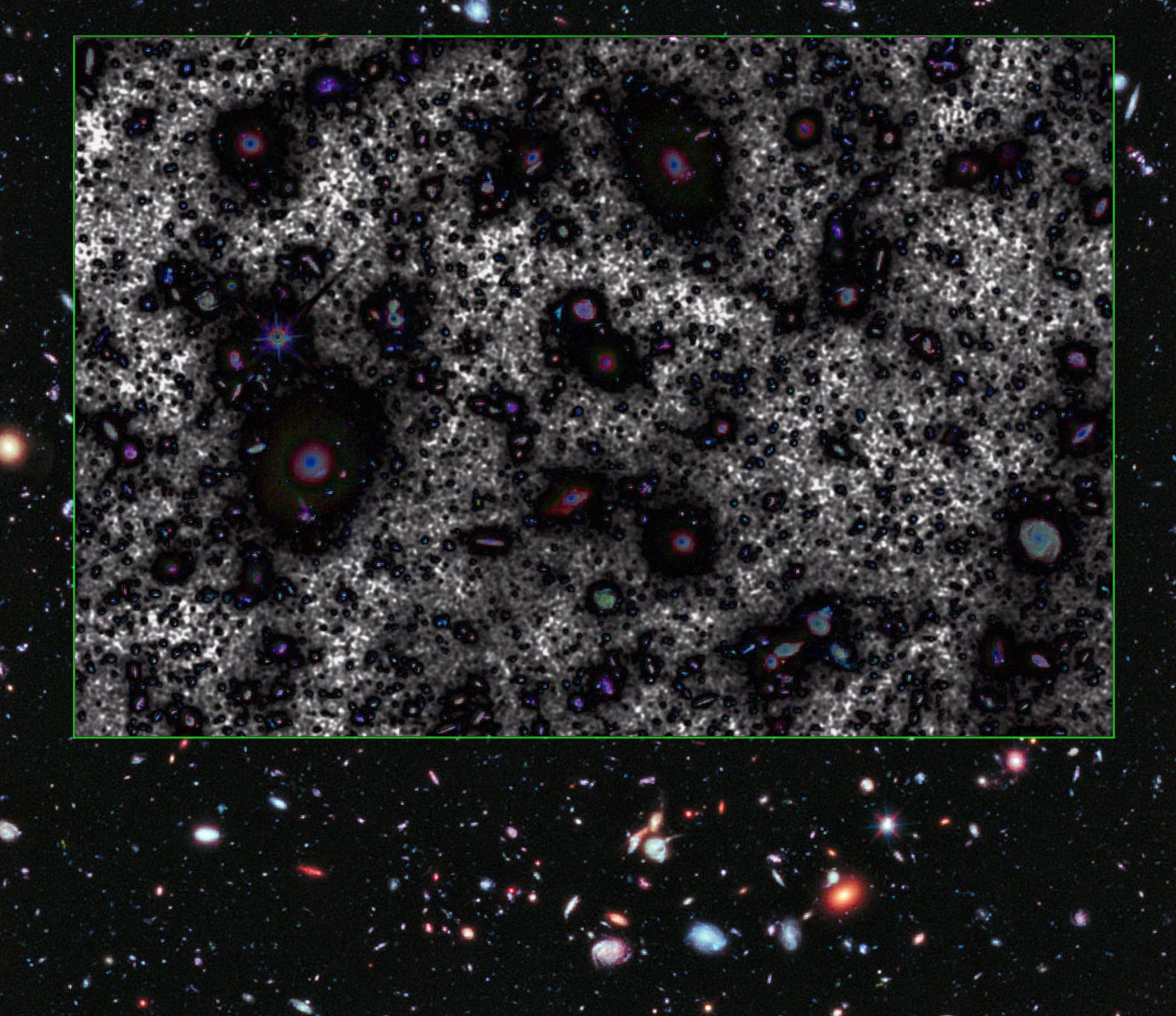Posted on 01/24/2019 1:15:13 PM PST by ETL
It has taken researchers at the Instituto de Astrofísica de Canarias almost three years to produce the deepest image of the universe ever taken from space, by recovering a large quantity of "lost" light around the largest galaxies in the Hubble Ultra-Deep Field survey.
To produce the deepest image of the universe, a group of researchers from the Instituto de Astrofísica de Canarias (IAC) led by Alejandro S. Borlaff used original images from the Hubble Space Telescope (HST) taken over a region in the sky called the Hubble Ultra-Deep Field (HUDF). After improving the process of combining several images, the group was able to recover a large quantity of light from the outer zones of the largest galaxies in the HUDF. Recovering this light emitted by the stars in these outer zones was equivalent to recovering the light from a complete galaxy ("smeared out" over the whole field) and this missing light shows that some galaxies have diameters almost twice as large as previously measured.
The HUDF is the result of combining hundreds of images taken with the Wide Field Camera 3 (WFC3) of the HST during over 230 hours of observation which, in 2012, yielded the deepest image of the universe taken until then. But the method of combining the individual images was not ideally suited to detect faint extended objects. Borlaff says, "What we have done is to go back to the archive of the original images taken by the HST, and improve the process of combination, aiming at the best image quality not only for the more distant smaller galaxies, but also for the extended regions of the largest galaxies.
The WFC3 was installed by astronauts in May 2009, when the Hubble had already been in space for 19 years. This presented a major challenge for the researchers because the complete instrument (telescope and camera) could not be tested on the ground, which made calibration more difficult. To overcome the problems, they analysed several thousand images of regions across the sky with the aim of improving the calibration of the telescope on orbit.
"The deepest image of the universe has been possible thanks to a striking improvement in the techniques of image processing which has been achieved in recent years, a field in which the group working in the IAC is at the forefront," says Borlaff.
Explore further: Hubble goes deep
More information: Alejandro Borlaff et al. The missing light of the Hubble Ultra Deep Field, Astronomy & Astrophysics (2018). DOI: 10.1051/0004-6361/201834312
Journal reference: Astronomy & Astrophysics
As a lay person I gave a sermon, with the original Hubble photo on a big poster as backdrop.
Part of it was to show the POWER of God.
Part of it was to show the LOVE of God. Something like: “The huge expanse of the heavens, so beyond our ability to understand - it reminds me of a daddy flinging his arms out and saying ‘I love you THIS much!’)
And it is an example of the infinite GRACE that He gives us, by the sacrifice of His infinite Son (the alpha and omega).
Great post.
Wonder how/why God picked the Earth out of untold planets.
I guess it had to be one of them :)
The telescope will be launched on an
Ariane 5 rocket from French Guiana in 2021."
Launched on a Ariane 5 rocket? Why not on a US rocket?
(and it's one helluva lotta H, etc)
A man was speaking: "The Hubble Ultra Deep Field image is incredibly important. When NASA aimed the world's most powerful telescope at an empty patch of sky the size of a grain of sand at arm's length, a patch that seemed utterly empty and devoid of any stars or galaxies or anything else, it captured an image of over 10,000 galaxies, each with hundreds of billions of stars. That image ought to be physically impossible."
A woman, possibly the interviewer, asked, "How do you mean 'impossible'?"
Suguha poked her head deep inside the refrigerator.
Where is that leftover KFC?
"Well, you have to understand the mathematics of it. It has to do with something called the alpha opacity function, a concept familiar to video game designers. In a 3-D video game, every object or texel is assigned an RGBA value: red, green, blue, alpha. The alpha value determines the the opacity of that the object or texel at that point. This determines its transparency: 0.0 is fully transparent, and 1.0 is fully opaque, typically scaled on integral values from 0 to 255. Video games are of course discrete, not continuous, simulations and therefore the RGBA values either quickly saturate - go to 1.0 - or remain at 0.0, nothing in-between.
"You see, achieving partial transparency that doesn't enfog the player is incredibly hard, and many video game designers simply cheat and create a fake fog that kicks in at a fixed distance. Creating a 3-D simulation over unimaginable distances while still revealing interesting objects at those distances is practically impossible."
"So you're saying it is probably not random."
Ah, there is the chicken bucket.
"The opacity gradient has to be inconceivably precise to be able to see such interesting details on literally the far side of the universe. For it to be merely random would be like hitting the Power Ball Jackpot. And you can't hand-wave it away with the Anthropic Principle either."
"So, in your opinion, the fact that we can see all those lovely swirling galaxies is not a coincidence?"
"No, it is not. And they shouldn't be 'swirling' either."
Hey, who ate all the drumsticks?
"How do you mean?"
"The pinwheel structure of a galaxy is mathematically impossible. Spiral galaxies simply shouldn't exist. Computational physicists have tried for decades to create computer simulations that would create a long-term pinwheel structure of a typical spiral galaxy and it just doesn't work, at least not without cheating. It always smears into a blob."
Suguha rolled her eyes while trying to ignore the audio.
Everyone in this house is a geek. Mom, Kazuto, Sachi. Why am I the only normal one?
"Then dark matter (DM) was discovered. Why does dark matter exist? There's no reason for it. It definitely exists - gravitational lensing reveals it everywhere in the cosmos - but there's nothing in the Standard Model that explains it. It's just there. But why? It's only use seems to be for creating interesting and beautiful galactic structures that we can actually see at cosmological distances."
"But why is it like that?"
Suguha sat on a chair at the breakfast nook and ate a cold chicken breast with her fingers.
The man's voice was getting excited. "Exactly! Don't you see what this means? The Hubble Ultra Deep Field is the 'smoking gun', so to speak. The fact that miraculous photo exists, that the Universe is seems to be carefully crafted so that we as humans can actually see all these amazing, beautiful, and glorious galaxies by the billions, strongly implies that someone or something..."
Suguha rolled her eyes.
You want to see a miracle?
Suguha picked up another piece of cold chicken as she tried to tune out the annoying video, which Midori continued to watch with keen interest.
The miracle is how my geek mother ever managed to marry a normal guy and make babies.
Suguha dug into the chicken wing.
I'm sure it has something to do with hussein
“Suguha picked up another piece of cold chicken as she tried to tune out the annoying video, which Midori continued to watch with keen interest.”
That was an interesting post. I like how it had the science and the chicken interupting MY concentration of the science part.
And while the image (to me) shows the hand of God, the description of the “impossible” science done by people shows how amazing humans are.
Psalm 8:
O LORD, our Lord,
how majestic is Your name in all the earth!
You have set Your glory
above the heavens.
From the lips of children and infants
You have ordained praise
on account of Your adversaries,
to silence the enemy and avenger.
When I behold Your heavens,
the work of Your fingers,
the moon and the stars,
which You set in place—
what is man that You are mindful of him,
or the son of man that You care for him?
You made him a little lower than the angels;
You crowned him with glory and honor.
You made him ruler of the works of Your hands;
You have placed everything under his feet:
all sheep and oxen,
and even the beasts of the field,
the birds of the air,
and the fish of the sea,
all that swim the paths of the seas.
O LORD, our Lord,
how majestic is Your name in all the earth!
I am so screwed
You can’t get there from here
From Wiki:
NASA, ESA and CSA have collaborated on the telescope since 1996. ESA’s participation in construction and launch was approved by its members in 2003 and an agreement was signed between ESA and NASA in 2007. In exchange for full partnership, representation and access to the observatory for its astronomers, ESA is providing the NIRSpec instrument, the Optical Bench Assembly of the MIRI instrument, an Ariane 5 ECA launcher, and manpower to support operations.[68][109] The CSA will provide the Fine Guidance Sensor and the Near-Infrared Imager Slitless Spectrograph plus manpower to support operations.[
We are stardust
We are golden
And we’ve got to get ourselves
Back to the garden
makes abstract expressionist art look like a kindergarten drawing
Very interesting -- BUT --that is not the HUDF, it is a portion of the HXDF (Hubble Extreme Deep Field) image that they processed.
I don't know what stunt this article is trying to pull -- but, that's definitely the
Hubble Extreme Deep Field Image at https://apod.nasa.gov/apod/image/1210/xdf_hubble_960.jpg...
~~~~~~~~~~~~
It took a bit of "processing and tweaking" (including a bit of rotation) to obtain registration, but here's the AOI/ROI of the HXDF that Canarias reported on:

And, here's the Canarias image, superimposed on the XDF:

And, even more convincing, Canarias at 45% opacity:

And, the pièce de résistance, Canarias subtracted from XDF -- leaving mostly Canarias' "intra-galactic 'imaging artifacts'" visible:

Seriously, I find reporting of the wrong base image to be deplorable -- but, I admit that those Canarias "imaging artifacts" (if they reflect actual objects/phenomena) may be their biggest contribution...
YMMV... '-)
TXnMA

TXnMA

Make a cool Desktop background. :)
Then came the "astroreferencing" (analogouus to terrestrial "georeferencing" of maps) -- including "tweaking" of magnification, aspect ratio, and a few degrees of fine rotation...
Fortunately, "Canvas", my "workhhorse" graphics engine, includes a wide variety of (variable) calculated transparency/opacity effects...
This processing of astro images seems to be fun. I just wonder why it took them three years. And, if they can prove that intergalactic "light noise" is real -- and not just an image processing artifact...
TXnMA

Yes, thank you. I explained earlier that it was I who changed the pic. I did it because the one at the site wasn’t clear enough. Unfortunately I replaced it with the wrong HDF. I then mislabelled it as the Hubble “Ultra” DF, instead of Extreme DF. Didn’t even know there was an Exteme HDF. Thanks again for the correction.
I think I’m even more excited about the LSST.
I did use it as that back when it first came out................
Well, not today, anyways................
Disclaimer: Opinions posted on Free Republic are those of the individual posters and do not necessarily represent the opinion of Free Republic or its management. All materials posted herein are protected by copyright law and the exemption for fair use of copyrighted works.